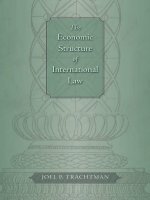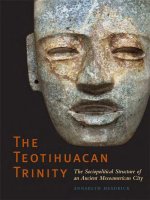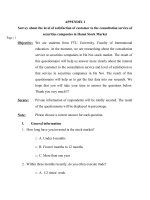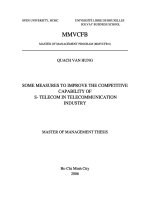Property rights as investment incentives the contractual structure of rd activities in biopharmaceutical industry
Bạn đang xem bản rút gọn của tài liệu. Xem và tải ngay bản đầy đủ của tài liệu tại đây (957.04 KB, 158 trang )
PROPERTY RIGHTS AS INVESTMENT INCENTIVES:
THE CONTRACTUAL STRUCTURES OF R&D ACTIVITIES IN
THE BIOPHARMACEUTICAL INDUSTRY
LI GANG
A THESIS SUBMITTED
FOR THE DEGREE OF DOCTOR OF PHILOSOPHY IN MANAGEMENT
DEPARTMENT OF BUSINESS POLICY
NATIONAL UNIVERSITY OF SINGAPORE
2008
ii
ACKNOWLEGEMENT
This dissertation would not be possible without the help and support from many of
my tutors, friends, and colleagues. I am greatly indebted to my supervisor, Associate
Professor Peter Hwang. Many of the ideas presented in this dissertation are originated
from my numerous discussions with him. He has the amazing ability to approach a
research question from many different angles. His piercing insights, disciplined
analysis, and his vigor in debates inspire me to think critically and help me to
improve the dissertation in many aspects.
I thank Associate Professor Andrew Delios and Dr Qiang Fu for the contributions that
they have made to my scholarly development, as well as to the improvement of this
dissertation. I will continue to seek their wise counsel in the years to come. I am
grateful to Associate Professor Ishtiaq Mahmood, Associate Professor Nitin
Pangarkar, Dr Kwanghui Lim, and Dr Chung Jaiho who provided me with valuable
remarks about not only my dissertation, but also how to be a true scholar.
I value the friendship that I have made with fellow students in NUS: Liu Wu, Wu
Zhijian, Qian Lihong, Ma Xufei, Ge Chang, Xiao Weiyun, Ajay S Gaur, and Zheng
Weiting among many others. They are the sparkles in the otherwise would-be dull
and stressful Ph.D life. I thank them to be important sources of my encouragement;
they have been my tutors at different points along the way. Last, but far from least,
many thanks to my sister Li Jing, and her family, for the love and support they have
iii
shown to me; and to my parents, Li Ciqi and Liu Yunsong, to whom this dissertation
is dedicated.
Needless to say, I am solely responsible for any errors or imperfections that may
remain in the dissertation.
Li Gang
Feb, 5
th
, 2008
iv
TABLE OF CONTENTS
SUMMARY v
LIST OF TABLES vii
LIST OF FIGURES viii
CHAPTER 1: INTRODUCTION 1
1.1 Theoretical Perspectives 2
1.2 Research Setting 4
1.3 Contribution 11
CHAPTER 2: TRANSACTION COST ECONOMICS AND PROPERTY 13
RIGHT THEORY: AN OVERVIEW
2.1 Incomplete Contract, Relation-Specific Investments, and Holdups 15
2.2 The Transaction Cost Approach 17
2.3 The Property Right Approach 21
2.4 An Attempt to integrate TCE and PRT
24
2.5 Review of Empirical Studies 33
CHAPTER 3: THE R&D BOUNDARY OF THE FIRM: THE CASE OF 51
BIOPHARMACEUTICAL INDUSTRY
3.1 Introduction 51
3.2 Biopharmaceutical Industry 53
3.3 The R&D Boundary of Pharmaceutical Firms 55
3.4 Hypotheses 60
3.5 Sample and Methodology 69
3.6 Results 80
3.7 Robustness Tests 86
3.8 Discussion 89
CHAPTER 4: ALLOCATING PROPERTY RIGHT TO MOTIVATE 96
PARTICIPANTS: THE CASE OF BIOTECH-PHARMACEUTIAL
ALLIANCES
4.1 Introduction 96
4.2 Theory and Hypotheses 99
4.3 Sample and Methodology 107
4.4 Results 115
4.5 Robustness Tests 119
4.5 Discussion 123
CHAPTER 5: CONCLUSION 127
BIBLIOGRAPHY 132
APPENDIX 150
v
SUMMARY
Both the Transaction Cost Economics (TCE) and the Property Right Theory (PRT)
start with the assumptions that transactions often involve with specialized investments
while contracts are incomplete. Holdups thus arise. Both the TCE and the PRT
maintain that the governance structure of a transaction matters in containing
inefficiencies associated with holdups. Much confusion arises: while some scholars
treat the TCE and the PRT as one stream of theory with the latter formalizing the
former, others contend that they are two distinct theories with different empirical
implications.
In this dissertation, I argued that the TCE and the PRT are two distinct theories; the
former assumes that integration results in unified management while the latter
assumes that the investment decisions remain decentralized after integration. I argued
that the explanatory power of the two theories depends on the context of a transaction:
the PRT is preferred in a context where trading partners differ significantly in their
knowledge bases, decision-making structures, and reward systems; the TCE is
preferred in a context that partners are similar. I found support for falsifiable
hypotheses that were developed based on above arguments by studying the
governance structures of 285 R&D projects in the biopharmaceutical industry.
vi
The PRT argues that opportunism exists in all kinds of organizational forms. In an
alliance, the optimal way of allocating property rights is to assign them to the party
whose investments critically affect the alliance performance. However, the party with
greater bargaining power tends to grab more property rights. As a result, the actual
allocation of property rights often deviates from the optimal way specified by the
PRT. By studying 222 biotech-pharmaceutical alliances, I found that the bargaining
power of a party is positively correlated with property rights assigned to her. I also
found that the prior interactions and the density of indirect channels between partners
contain the negative impact of misallocating property rights on alliance performance.
I therefore concluded that it is necessary to consider the effects of the social contexts
in evaluating the impact of formal contractual structures on alliance performance.
vii
LIST OF TABLES
TABLE 2.1 EMPIRICAL STUDIES TESTING THE TCE 35
TABLE 3.1 COMPARISON OF BIOTECH AND
PHARMACEUTICAL COMPANIES 71
TABLE 3.2 DESCRIPTIONS OF VARIABLES 78
TABLE 3.3 NATIONALITY OF SAMPLE FIRMS 81
TALBE 3.4 DESCRIPTIVE STATISTICS AND CORRELATIONS 82
TABLE 3.5 BINARY REGRESSION RESULTS 83
TABLE 3.6 ROBUSTNESS ESTIMATIONS 87
TABLE 3.7 RESULTS OF HLM ANALYSIS 89
TABLE 4.1 DESCRIPTIONS OF VARIABLES 113
TABLE 4.2 DESCRIPTIVE STATISTICS AND CORRELATIONS 114
TABLE 4.3 BARGAINING POWER AND
THE ALLOCATION OF MARKETING RIGNTS 116
TABLE 4.4 ANALYSIS OF ALLIANCE PERFORMANCE 118
TABLE 4.5 OUTCOMES OF ALLIANCES 119
TABLE 4.6 RESULTS OF MULTINOMIAL REGRESSION 121
TABLE 4.7 BINARY LOGIT REGRESSIONS FOR EACH
STEP OF PROGRESS 122
TABLE 4.6 THE MODERATING EFFECTS OF
SOCIAL CONTEXTS ON MISALLOCATION 125
TABLE A1 ORDERED LOGISTIC ANALYSIS OF R&D PROGRESS 149
viii
LIST OF FIGURES
FIGURE 3.1 GOVERNANCE STRUCTURES OF
BIOPHARMACEUTICAL R&D PROJECTS, 1997-2004 57
FIGURE 3.2 SAMPLE BREAKDOWN ACCORDING
TO DEVELOPMENT STAGES 72
FIGURE 3.3 SAMPLE BREAKDOWN ACCORDING
TO THE NUMBER OF R&D PROJECTS 73
FIGURE 4.1 SAMPLE BREAKDOWN ACCORDING
TO ALLIANCE DURATION 109
FIGURE 4.2 SAMPLE BREAKDOWN ACCORDING
TO ALLIANCE PROGRESS 110
1
Chapter 1 Introduction
The ability of firms to continually update and exploit their knowledge bases has
become an imperative for their competitive survival (Kogut and Zander, 1992; Cohen
and Levinthal, 1990; Grant, 1996; Ahuja and Katila, 2001; Vermeulen and Varkema,
2001; Azoulay, 2004). Firms‘ internal research and development (R&D) capabilities
are often viewed as a critical determinant of their performance (Kogut and Zander,
1992; Grant, 1996; Ahuja and Katila, 2001; Azoulay, 2004). However, in-house R&D
is not the only possible source of technological know-how: firms can tap the R&D
capabilities of competitors, suppliers, and other organizations through contractual
arrangements such as licenses, collaborations, and joint ventures (Pisano, 1990;
Vermeulen and Varkema, 2001; Zucker, et al., 2002; Owen-Smith and Powell, 2004).
What are the factors that may affect a firm‘s choices between obtaining R&D services
through acquisitions and through collaborations? This remains one of the central
questions in the economics of organization and the strategy literature (Pisano, 1990;
Poppo and Zander; 1998; Leiblein, et al., 2002; Schilling and Steensma, 2002).
R&D procurement decisions are of particular importance for established companies
confronting critical changes in their core technologies (Pisano, 1990; Powell, et al.,
1996; Zucker, et al., 2002; Schilling and Steensma, 2002). During such gusts of
creative destruction, established firms‘ research teams may lock-in the conventional
techniques and lack the technological skills to perform R&D competitively compared
to new entrants. Boundary decisions have to be made about which new technical
2
capacities to develop internally and which ones to access through collaborative links
with external sources (Pisano, 1990; Powell, et al., 1996; Nicholson, et al., 2005).
Moreover, how to manage collaborative relationships that often involve with
frustrations such as free-riding, appropriation and other contractual hazards represents
another challenge to firms (Oxley, 1997; Gulati and Singh, 1998; Lerner and Merges,
1998; Reuter, et al., 2002).
In this dissertation, I examined the contractual arrangements of R&D projects in the
biopharmaceutical industry. The newly invented biotechnologies such as
DNA/protein synthesizing and cell fusion have fundamentally changed the
competitive landscape of the pharmaceutical industry (Powell, et al., 1996; Lerner, et
al., 2003; Phene, et al., 2006). Such a dramatic technological change provides an
opportunity to examine how established firms adjust their R&D boundaries to cope
with the technological uncertainty and how they manage the contractual provisions of
an R&D partnership (Aghion and Tirole, 1994; Lerner and Merges, 1998; Roijakkers
and Hagedoorn, 2006). Drawing upon the property right theory, I attempt to address
these questions in this dissertation.
1.1 Theoretical Perspectives
The boundary choices of firms have attracted much attention from scholars
(Williamson, 1975, 1985, 1991, 2000; Klein, et al., 1978; Grossman and Hart, 1986;
Holmström and Roberts, 1998; Gibbons, 2005). Two streams of work have made
3
profound impacts on the studies of organization: the Transaction Cost Economics
(TCE) based on the works of Williamson (1975, 1979, and 1985) and Klein,
Crawford, and Alchain (1978); and the Property Right Theory (PRT) began with
Grossman and Hart (1986) and Hart and Moore (1990).
The TCE has emerged as a predominant theoretical perspective in the economics of
organization during the past three decades (Williamson, 2000; David and Han, 2005;
Cater and Hodgeson, 2006). Scholars argue and empirically find that the governance
structure of a transaction is determined largely by the specificity of assets involved in
a trading relationship (Shelanski and Klein, 1995; David and Han, 2005; Cater and
Hodgeson, 2006). Asset specificity triggers a threat of opportunistic behaviors that
requires contractual safeguards to deter. Since those safeguards are costly and are
often unable to protect trading partners completely, vertical integration may offer a
preferred governance solution (Williamson, 1975, 1985; Monteverde and Teece, 1982;
Teece, 1992; Shelanski and Klein, 1995).
Similar to the TCE, the PRT starts with the assumptions that contracts are incomplete
and investments are relation specific (Grossman and Hart, 1986; Hart and Moore,
1990; Hart, 1995). However, while the TCE implicitly assumes that vertical
integration results in unified management and contains opportunism, the PRT
maintains that investments and trading decisions remain decentralized in all
organizational modes (Holmström and Roberts, 1998; Whinston, 2003; Gibbons,
2005; Garrouste and Saussier, 2005). Transferring ownership from one party to
4
another incurs costs because integration lowers the incentive of the party who loses
ownership. The low incentive level in turn links to the decision of underinvestment
since the unified management is assumed away (Grossman and Hart, 1986; Hart and
Moore, 1990; Hart, 1995). What the PRT is about is to properly allocate property
rights so that joint surplus is maximized.
In Chapter 2, I reviewed and compared the TCE and the PRT. I argued that the
integration of two organizations is unlikely to lead to unified management under three
conditions: A) The knowledge bases of the two parties are remotely related; B) The
decision-making structures of the two parties are incompatible; and C) The reward
systems of the two parties are different. Under such circumstances, integration may
incur significant costs as the merged organization may not be able to properly
monitor and motivate the party who loses its ownership. The PRT therefore expects
that trading partners maintain their independence, even when high asset-specificity
presents.
1.2 Research Setting
In view of the wealth of theoretical literatures of the PRT, it is surprising that only a
small number of empirical research study the formal structures of transactions from
this perspective (Williamson, 2000; Whinston, 2003; Gulati, et al., 2005; Baker and
Hubbard, 2006). In this dissertation, I attempt to fill this gap by examining the
5
boundary choices of a firm from the PRT perspective. I also study how the property
rights are allocated between alliance partners.
A. The R&D Boundary of a Pharmaceutical Company
A pharmaceutical company can either bring R&D activities ‗in-house‘ by acquiring a
biotech firm or outsource those activities through inter-firm collaborations.
Biotechnology R&D projects require highly specialized investments in both physical
assets and human skills (Arora and Gambardella, 1990; Powell, et al., 1996; Yeoh
and Roth, 1999; Nicholson, et al., 2005). Uncertainty pervades the process of
discovering, synthesizing, and formulating a therapeutic bioscience-based compound
(Pisano, 1990; Yeoh and Roth, 1999; Roijakkers and Hagedoorn, 2006). Because
such a project may run for several years, it has more characteristics of a long-term
recurrent transaction than those of a one-shot exchange (Pisano, 1990; Yeoh and Roth,
1999). The TCE suggests that integration is required to safeguard the relational-
specific investments in a relationship characterized by high asset-specificity,
uncertainty, and frequency (Williamson, 1975, 1985, 1991; Teece, 1989; Pisano,
1990; Shelanski and Klein, 1995; David and Han, 2004; Carter and Hodgeson, 2006).
Hierarchy is therefore the preferred organizational form of such R&D projects
according to the TCE.
However, scholars observed that a majority of R&D projects were administrated by
inter-firm collaborations rather than integration in the biopharmaceutical industry
6
(Lerner and Merges, 1998; DiMasi, 2000; Nicholson, et al., 2005). For example,
DiMasi (2000) reported that, from 1997 to 1999, over 70% of all R&D projects in this
industry were conducted through inter-firm collaborations. Nicholson, et al., (2005)
reported that of the 391 new chemical entities approved by the FDA between 1983
and 1999, more than half were discovered by inter-firm collaborations. These
observations are explicitly at odds with the predictions of the TCE.
In contrast to the TCE, the PRT suggests that the governance structure of a
transaction is about to balance the benefits and costs of allocating ownership between
parties so that each party‘ incentive is properly set and the joint economic surplus is
maximized (Grossman and Hart, 1986; Hart and Moore, 1990; Gibbons, 2005). The
knowledge base, the decision-making structure, and the reward system of a
pharmaceutical company and those of its biotech counterpart may differ significantly.
It is therefore difficult for a pharmaceutical company to effectively monitor and
motivate its biotech partner after integration. The high costs associated with low
incentive level of a biotech firm deter a pharmaceutical company from acquiring its
biotech partner. Under such circumstances, contractual arrangements such as licenses,
R&D collaborations, and joint ventures may be the favorable choices.
The TCE and the PRT differ in their predictions of the governance structures of less
mature R&D projects. The technologies covered by an R&D project are frequently in
the early stages of research exploration. Such less mature projects often involve
significantly more technological uncertainties than more mature ones. The end-points
7
of those projects and efforts of biotech firms are difficult to specify in an enforceable
contract. Significant financial supports are required which generates knowledge that
may not be useful to other applications (Arora and Gambardella, 1990; Powell, et al,
1996; Yeoh and Roth, 1999). The TCE therefore predicts that a pharmaceutical
company is more likely to internalize those early stage R&D activities (Pisano, 1990).
However, the research contributions of a biotech firm tend to be particularly critical
in a less mature project (Arora and Gambardella, 1990; Powell, et al, 1996; Lerner, et
al., 2003). Losing the autonomy in decision-making or changing the market-based
compensation system of a biotech firm is costly. From a PRT perspective, it may be
preferable to let the biotech partner remain independent in a transaction involves with
less mature R&D projects (Grossman and Hart, 1986; Lerner and Merges, 1998).
The predictions of the TCE and the PRT also differ in the governance structures of
transactions involving biotech firms with a number of R&D projects. Biotech firms
frequently pursue various R&D projects simultaneously, and not all projects are
covered by the contract (Pisano, 1990; Lerner and Merges, 1997; Owen-Smith and
Powell, 2004). Biotech firms are therefore left with leeway to exploit the resources
contributed by pharmaceutical companies in projects that are not included in a
contract (Pisano, 1997; Lerner and Merges, 1998; Lerner, et al., 2003). According to
the TCE, efficiency could be gained by containing such contractual hazards through
vertical integration. However, as convincingly argued by Henderson and Cockburn
(1996), there were significant spillover effects between R&D projects within a firm in
the biopharmaceutical industry. Biotech firms pursuing a number of projects may
8
enjoy the economy of scope and may be significantly more productive than those
with a handful of projects. Lowering the incentive of such biotech firms by
acquisition incurs significant costs. Other contractual arrangements such as
collaborative agreements may therefore be preferred.
The differences in the knowledge bases, the decision-making structures, and the
reward systems between a pharmaceutical company and its biotech partner may
significantly affect the cost of integration. When such differences are negligible, a
pharmaceutical company can monitor the behaviors of its biotech partner. Motivating
the biotech party is less of a concern. Unified management is likely to archive after
integration and the costs of integration are reduced. What we observe is therefore
more likely to be consistent with the predictions of the TCE than with those of the
PRT. When the differences between the pharmaceutical firm and its biotech partner
are significant, however, integration is costly since it is difficult for the former to
monitor and motivate the latter. What we observe is more likely to be consistent with
the predictions of the PRT than with those of the TCE.
In Chapter 3, I constructed a sample containing 285 biotechnology R&D projects to
test the predictions of the PRT. My results generally support those predictions. I also
explored the moderating roles of the knowledge bases, the decision-making structures,
and the reward systems in Chapter 3.
B. Allocation of Property Rights in Biotech-Pharmaceutical Alliances
9
The allocation of property rights also matters in managing inter-firm R&D
collaborations between pharmaceutical companies and biotech firms (Aghion and
Tirole, 1994; Lerner and Merges, 1998; Lerner, et al., 2003). The PRT suggests that
the property rights of an R&D project should be assigned to the party whose efforts
critically affect the joint performance. Aghion and Tirole (1994) argued, however,
that the ex ante bargaining power of trading partners may have a profound impact on
the allocation of property rights. In the biopharmaceutical industry, financial
constraints of a biotech firm weaken its bargaining position and induce its
pharmaceutical partner to inefficiently retain some property rights. A suboptimal
performance level therefore results (Lerner and Merges, 1998; Lerner, et al., 2003).
In practice, trading partners reveal much more complex interaction patterns than the
‗one-shot‘ contracts depicted in Grossman and Hart (1986) and Aghion and Tirole
(1994). Pairs of firms undertake repeated sets of alliances on different topics, and the
scope and scale of such alliances change over time. Firms engaged in repeated
relationships know each other better. They are familiar with each other‘s ways of
doing thing and hence tend to trust each other (Gulati, et al., 1995; Dyer, 1996; Oxley,
1997; Gulati and Singh, 1998). Moreover, referential information is available through
a variety of channels such as comments from a third party. When the reputation effect
is important, firms would concern about how their current behaviors affect their
future transactions. Socially undesirable behaviors are therefore discouraged (Kreps,
1990; Raub and Weesie, 1990; Kandori, 1992).
10
Trust and reputation concerns give rise to hand-in-glove agreements through which
parties reach accommodations when unforeseen events occur (Kogut, et al, 1992;
Oxley, 1997; Gulati and Singh, 1998). As an example for such an agreement, a
pharmaceutical company may promise a biotech firm a bonus if the proposed drug
candidate is successfully delivered. Such a promise is credible only when trust and
reputation effects are substantial (Kandori, 1992; Baker, et al., 2002). Those informal
agreements to a certain extent relieve worries of appropriation, and hence substitute
formal contracts to motivate a party to take initiatives (Cusumano and Takeishi, 1991;
Baker, et al., 2002). As a result, although the property rights are inefficiently
allocated, an inter-firm collaboration still stands a chance to be successful (Bull, 1987;
Cusumano and Takeishi, 1991; Baker, et al., 2002). Thus, partners interacting in a
social context characterized by high level of trust and strong reputation concerns are
reluctant to defect from an informal agreement, and the negative impact of the
misallocation of property rights on alliance performance are mitigated (Baker, et al.,
2002; Nicholson, et al. 2005).
In Chapter 4, I found a significant negative relationship between the ex ante
bargaining power and the degree of property rights misallocation by examining a
sample of 222 biotechnology alliances. I also found that the misallocation of property
rights significantly relates to the early dissolution of an alliance and the slow progress
of R&D projects. The significances of such correlations are weakened when partners
share a history of prior interaction or they are embedded in an extensive network
11
characterized by strong reputation effect. I further explored the reasons underlying
early dissolutions of alliances which carry important implications for both academic
research and management practice.
1.3 Contribution
The theoretical contribution of this thesis is two-fold. First, I clarify the confusion
surrounding the TCE and the PRT by specifying the situations under which their
predictions differ significantly. Second, I highlight the importance of considering the
social contexts when studying the contractual structures of transactions. The
benevolent social contexts characterized by mutual trust and reputation concerns
mitigate the negative impact of suboptimal contractual structures on performance.
In this dissertation, I show that the PRT is a data-relevant theory, and can be applied
to explain a broad range of phenomena. ―[T]heory without evidence is, in the end,
just speculation.‖ (Masten, 2002:428). The two well-recognized critics to the PRT are
that a) it makes limited contact with the data; and b) it is a property right and property
right only theory, which has limited power in explaining phenomena other than
integration (Williamson, 2000). In this dissertation, I show that the PRT can be tested
by a structured dataset. Other than integration, I also apply the PRT in issues of
managing inter-firm collaborations.
12
This dissertation is organized as follows. In Chapter 2, I provide a brief review that
compares the TCE and the PRT. In Chapter 3, I develop testable hypotheses about the
R&D boundaries of a pharmaceutical company. I then test those hypotheses in the
context of the biopharmaceutical industry. In Chapter 4, I study the allocation of
property rights among alliance partners and its performance implications. Empirical
tests follow. Chapter 5 concludes this dissertation.
13
Chapter 2
Transaction Cost Economics and Property Right Theory: An
Overview
What is a firm? What determine the boundaries of a firm? These are the central
questions in the economics of organization (Williamson, 1975; Holmström and
Roberts, 1998; Gibbons, 2005). Two streams of work have made profound impacts on
the studies of organization: the Transaction Cost Economics (TCE) based on the
works of Williamson (1975, 1979, and 1985) and Klein, Crawford, and Alchain
(1978); and the Property Right Theory (PRT) began with Grossman and Hart (1986)
and Hart and Moore (1990).
Both the TCE and the PRT assume that investments are relation-specific and
contracts are incomplete (Williamson, 1975; Grossman and Hart, 1986; Holmström
and Roberts, 1998; Whinston, 2003; Gibbons, 2005). Trading partners are locked in a
relationship since their specialized investments worth much less in options outside the
relationship. Contractual incompleteness gives rise to opportunism. As a result, one
party may holdup the other party to increase her share of the economic rents. Both the
TCE and the PRT propose that the governance structure of a transaction matters in
containing the inefficiencies associated with holdups. Some scholars treat the TCE
and the PRT as one stream of theory with the latter formalizing the former (Shelanski
and Klein, 1995). Others, however, contend that they are two distinct theories with
14
different empirical implications (Holmström and Roberts, 1998; Williamson, 2000;
Whinston, 2003; Gibbons, 2005; Garrouste and Saussier, 2005).
Holmström and Roberts (1998) provided the first systematic comparison of the TCE
and the PRT. They contended that there are certainly points of similarity between
these two theories, but the detailed logic of them is different, resulting in quite
different empirical predictions. Whinston (2003) and Gibbons (2005) argued that an
important difference between the TCE and the PRT is that the former assumes that
common ownership results in unified management, whereas the latter assumes that
investment decisions are fundamentally decentralized in all organizational modes.
While in the TCE opportunism can be contained by bringing the transactions within
the firm, the PRT maintains that mitigating opportunism by integration is at the cost
of the party been integrated losing her incentive to invest (Williamson, 2000;
Whinston, 2003; Gibbons, 2005). In this chapter, I argued that the cost of integration
is significant in three conditions. First, the knowledge bases of the two parties are
unrelated. Second, the decision-making structures of the two parties are different.
Lastly, the reward systems of the two parties are incompatible. Under such
circumstances, it is difficult for the acquirer to effectively monitor and motivate the
acquiree. Integration therefore incurs high cost.
In the next section, I discuss the common pre-assumptions of the TCE and PRT—the
incomplete contract and asset-specificity—and their roles in giving rise to holdups. I
review the TCE and the PRT respectively in section 2.2 and 2.3. I then specify the
15
differences between the two and try to integrate their predictions by using the concept
of three organizational contexts: the knowledge bases, the decision-making structures,
and the reward systems. A review of empirical studies is provided in Section 2.5.
2.1 Incomplete Contract, Relation-Specific Investment, and Holdup
Holdup has been centered in the theory of the firm and both the TCE and the PRT are
advanced to address this problem. It arises in a relationship when a contract is
incomplete and relational-specific investments are involved (Shelanski and Klein,
1995; Holmström and Robert, 1998; Williamson, 2000; Whinston, 2003; Gibbons,
2005).
Both the TCE and the PRT maintain that in a complex world, contracts are typically
incomplete since informational complexity constrains the design of contracts and
agents are ‗intendedly rational, but only limitedly so‘ (Simon, 1961: 204). Some
actions of an agent may neither be observed nor be verified, making contractual terms
unenforceable (e.g., see Hart and Moore, 1990 for a discussion of investments on
human capital; see Aghion and Tirole, 1994 and Tirole, 1999 for a discussion of
investments in an R&D project). It may be impossible to clearly elicit the behaviors
of each party in a contract based on only observable and verifiable variables.
Contracts are then said to be incomplete.
16
The presence of relation-specific investments that generate quasi-rents is another
precondition for holdups (Williamson, 1975, 1985, 1991; Klein, et al., 1978).
Relation-specific investments refer to those that will have much lower value in any
use other than supporting the current transactional relationship. Because it is
impossible to elicit all ex post contingencies that might affect the division of quasi-
rents, the party who makes the relation-specific investment is subject to holdups: her
counterparts may ask for a share of the economic surplus that should belong to her,
and she may have to agree since her investments worth much less in alternative uses.
Trading partner who commits relation-specific investments thus exposes herself to the
hazards of opportunistic behaviors in ex post small-number-bargaining: her
counterparts may try to appropriate the quasi-rents accruing to the specific assets. As
Masten (1984) put it:
Idiosyncratic assets, because of their specialized and durable nature, imply that parties to
a transaction face only imperfect exchange alternatives for an extended period. The more
specialized those assets, the larger will be the quasi-rents at stake over the period, and
hence the greater the incentive for agents to attempt to influence the terms of trade
through bargaining or other rent-seeking activities once the investment are in place.
Klein et al. (1978) elaborated the relationship between an automaker and his suppliers
to illustrate this holdup situation. Suppliers use dies to shape steel into the specific
forms that fit in a particular car model. These dies often cost millions of dollars, and
they are next-to-worthless when they are not used in the model. A supplier is then
vulnerable to holdups since the automaker may take advantage of the fact that the dies
17
can hardly be used elsewhere to force a price reduction and grab some economic
surplus. Since the original contract is incomplete as the uncertainties with respect to
the design of a car and market conditions prevent a clear division of economic surplus
ex ante, a supplier either is unwilling to make a specific die in the first place or have
to command resources to protect herself from holdups. Inefficiency thus occurs:
either the arm-length market does not support the optimal level of investments or
resources are expended on socially wasteful defensive measures.
Both the TCE and the PRT are advanced to address holdups caused by incomplete
contract and asset specificity. A confusion is emerged that some scholars tend to treat
the TCE and the PRT as one stream of theory with the latter formalizing the former.
However, this is not the case. As Holmström and Roberts put it (1998: 75):
Discussions of the holdup problem and its implications for firm boundaries typically list a
standard string of references — including Williamson (1975, 1985), Klein et al. (1978),
Grossman and Hart (1986), and Hart and Moore (1990) — as if they were the building
blocks in a single coherent theory of ownership. This is not the case. There are certainly
points of similarity… But the detailed logic of the stories differs, resulting in quite
different empirical predictions.
2.2 The Transaction Cost Approach
The TCE is premised on the idea that certain institutional arrangements govern a
transaction better than others, depending on the characteristics of the transaction in









